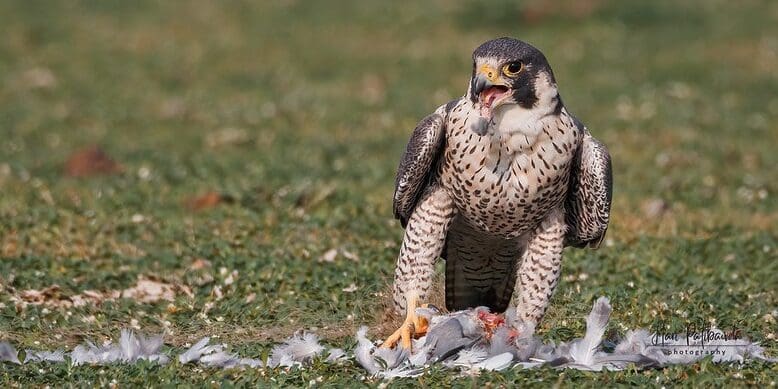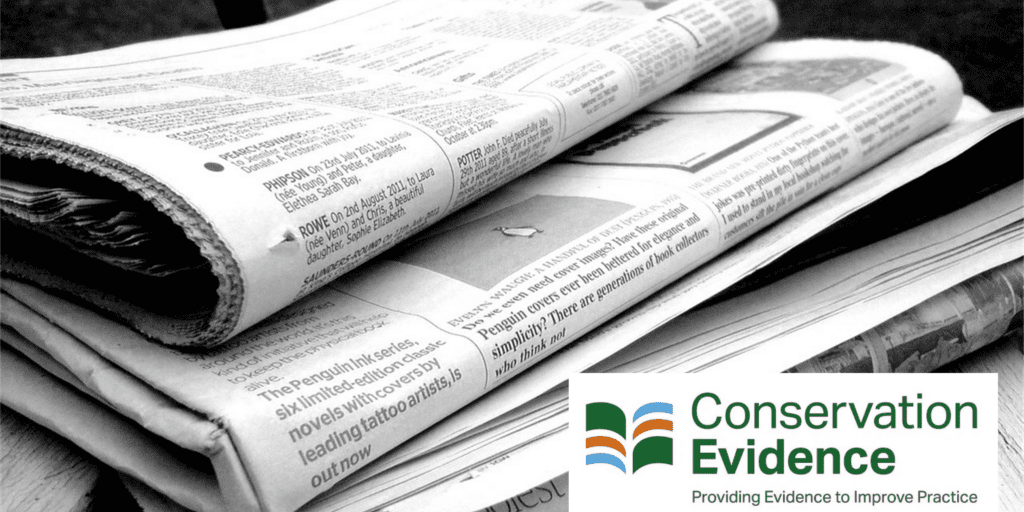What are we working on at Conservation Evidence?
This blog post is a quick overview of what the Conservation Evidence team are working on. We’ve listed some of our recent and ongoing activities. Please follow the links, or contact us, if you want to know more about any of our work.

Synopses: We are currently working on two synopses that synthesize global evidence for the effects of conservation interventions. These ultimately form the content for the Conservation Evidence database. Nigel and Vanessa are working on the synopsis for inland aquatic vegetation (in rivers, lakes, ponds, estuaries and lagoons). We’re aiming for this to be published in mid-2024. The protocol is available here. Ann and Ellie are working on the synopsis for coral reef conservation. This should be published in late 2024. You can read the protocol here.

Funders workshop: In February 2023, in collaboration with the Environmental Funders Network and the Endangered Landscapes Programme, we ran a very successful workshop with 30 conservation funders interested in using evidence to increase their effectiveness. The aim was to discuss how best to ensure that evidence is incorporated into funding decisions and how to learn from conservation practice. Eight funders presented how they encourage applicants to include evidence of the effectiveness of actions in proposals and others explained how they promote and support tests of actions within projects. Great discussions followed. You can read more about the workshop here. We plan to hold another workshop for funders this autumn focused on testing management interventions, if you are interested get in touch with Rebecca.
Conservation Evidence Journal: Our journal welcomes submissions that test conservation interventions and quantify their effects on biodiversity. All articles are free to publish and free to read. Recent highlights include a study showing that artificial light could be used to grow certain aquatic plants in rivers shaded by bridges and culverts, and a study showing that three years into a voluntary transition period towards non-lead shot, 94% of pheasants in Great Britain are still killed with lead ammunition.

Workshops on evidence needs
For improving the management or restoration of forests and woodlands: Conservation Evidence, Forestry England, Forest Research and the Woodland Trust held a workshop with attendees including representatives from DEFRA, NatureScot, Natural England and the RSPB. Priorities from the meeting were to: (1) develop taxonomies of standard terms (i.e. woodland types, actions, targets, outcomes), (2) collate and review the evidence on the effectiveness of woodland management actions for biodiversity (building on that already collated in the Conservation Evidence database) and (3) embedding of material into tools and encouraging use.
For management of invasive species: We convened a workshop with UK invasion biology and policy stakeholders, with representation from DEFRA, the Environment Agency, NatureScot and the GB Non-native Species Secretariat. Gaps identified included: a need to improve our fundamental understanding of invasive species, invasion ecology and current and future ranges of invasive species; a need to standardize monitoring techniques and methodologies; and a need to improve public engagement. Three key actions arising were: (1) establishing a set of clear arguments for the need for evidence-based management of invasives, (2) soliciting an invasive-species-specific funding call and the formation of an associated doctoral training program, and (3) developing a simple app or tool to centralize information of invasive species management efforts and encourage robust testing of management actions.
Metadataset for EU priority invasive species: Metadataset is a free online tool that we have developed to enable users to interact with a global evidence base, to find quantitative evidence that is relevant to their decision making needs. As well as browsing evidence maps to find publications on a specific intervention, outcome, or country, users can also try a new method of interactive evidence synthesis that we call “dynamic meta-analysis“. Dynamic meta-analysis allows users to filter and exclude data that is not relevant to their context, and give studies weights depending on their perceived relevance. Metadataset is currently focused on collating evidence for interventions aiming to control the 88 invasive species of European Union concern. Data are uploaded in a systematic, iterative and ongoing process. In the coming months all relevant data on these species from the Conservation Evidence database will have been added to Metadataset. Data entry for the management of invasive plants is complete, and data entry for invasive animals is underway.

Evidence-based guidance co-production
Amphibians and roads: Silviu is working to co-develop with experts a pragmatic guidance document on impact mitigation for amphibians and reptiles in the UK, in relation to roads. This approach uses the principles of evidence-based guidance developed by the Conservation Evidence team in 2022 by making it clear what evidence exists (or doesn’t) for specific action recommendations and advice, in order to transparently improve decision-making in this important conservation topic. This project is funded by Natural England.
Seabirds and climate change: We’ve been finishing off a project, in collaboration with the Zoological Society of London, to co-produce conservation guidance for seabirds in the North-East Atlantic. This includes evidence on traits that could affect seabirds’ ability to cope with climate change, observed threats to seabirds, and potential conservation actions to address these threats. The co-production process is described in a recent paper, and the guidance will soon be published as an open access book.
Guidance for coastal restoration: We are just starting to develop some guidance for salt marsh and mudflat restoration, with a focus on China and the Yellow Sea. This project will run in the second half of 2023; we plan to publish the guidance in early 2024.
Field visits combining evidence sources to support decision making: As part of the Centre for Landscape Regeneration, we’ve been running a series of field workshops East Anglia, using evidence to support practical conservation. Each workshop visits a Fenland site that has questions about nature conservation. These form the basis of discussion amongst participants. We combine local knowledge and experience with published scientific evidence to help the site managers make n informed conservation decisions. The next workshop will be on September 5th 2023 near Downham Market, Norfolk, UK. If you are interested in attending please contact Vanessa.

One PhD finished… Tom submitted his thesis in March 2023 and had his viva in May. His work looks at how conservation outcomes and costs are measured, and how evaluation and decision-making tools from other sectors can be applied to identify those solutions that represent the best use of limited conservation funds. Many of his chapters have already been published. Tom now splits his time between being a postdoc at the Interdisciplinary Centre for Conservation Science in Oxford, and a consultant with The Biodiversity Consultancy in Cambridge.
…and another just beginning: Ashley joined the Conservation Evidence team in October 2022. In his PhD, Ashley is aiming to leverage a range of global datasets to determine the most effective actions for conserving species, including for species with no available evidence on what is effective.
Awards and Prizes: We are delighted that the founder of Conservation Evidence, Professor William Sutherland, was recently elected a Fellow of the Royal Society, the UK’s national science academy and the oldest in continuous existence. Our book Transforming Conservation: A Practical Guide to Evidence and Decision Making has been nominated for a Best Practice (Knowledge Sharing) award by the UK Chartered Institute for Ecology and Environmental Management. The University of Cambridge was also awarded a Silver Medal by the Council for Support and Advancement of Education for its video showcasing Conservation Evidence:
Over the coming months, we will continue working to provide evidence for conservation practice, support the use of evidence to deliver effective conservation action, and encourage experimental tests of conservation actions. We’ve got various ‘irons in the fire’ to help us do this and we look forward to updating you on these in the future.



